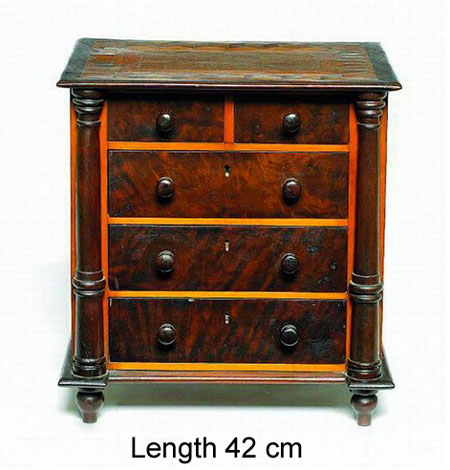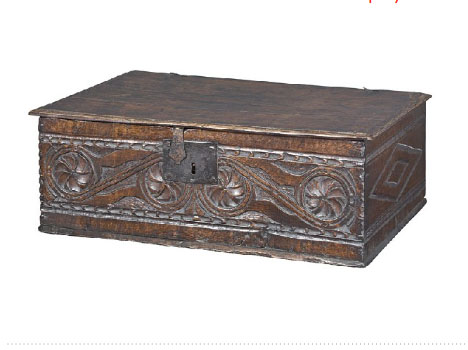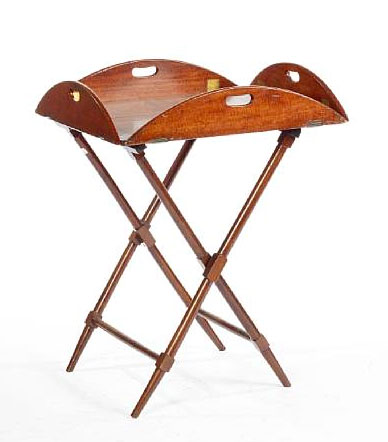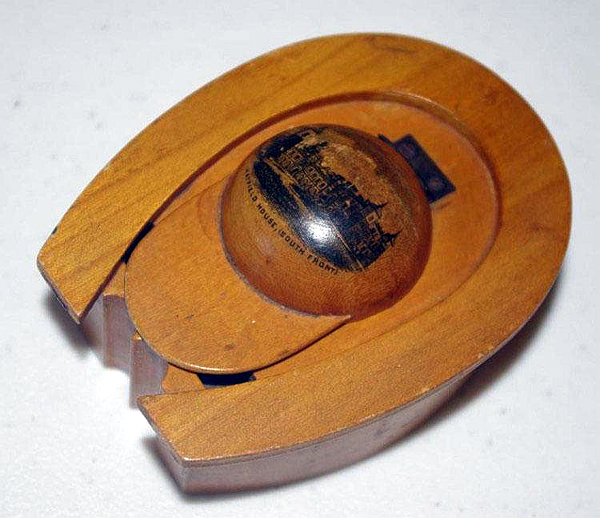Learn about antiques and collectables...
Click on a category below to show all the entries for that category.
Learn about and understand the items, manufacturers, designers and periods as well as the specialist terms used in describing antiques and collectables. Either click one of the letters below to list the items beginning with that letter, or click on a category on the left side of the screen to list the items under that category.
Apprentice Furniture
Small-scale versions of cabinet furniture, sometimes made by apprentice craftsmen to demonstrate their technical skills. More commonly, such pieces were made by skilled tradesmen and taken around country districts by journeymen or commercial travellers, so customers could order household furniture from these samples. Miniature furniture pieces, often made for children, are frequently described as apprentice pieces. They are now highly sought after, but, buyer beware, the market abounds with many imported and locally produced 'apprentice pieces' of more recent manufacture.
Australian Cedar
Australian cedar, also known as red cedar or Toona ciliata, is a species of tree that is native to eastern Australia. It is known for its high-quality timber, which has a distinctive red color, fine grain, and a pleasant aroma. In the 19th century, Australian cedar was widely used in the manufacture of furniture, particularly in Australia and the United Kingdom.
The timber was considered to be a highly desirable material for furniture making due to its strength, durability, and natural resistance to rot and insects. It was also relatively easy to work with and could be finished to a high standard and was used to make a wide range of furniture items, including tables, chairs, wardrobes, and chests of drawers.
Australian cedar furniture was particularly popular in the Victorian era and was considered to be of very high quality. However, over-harvesting of the tree led to a decline in the availability of the timber and as a result, the use of Australian cedar in furniture making decreased in the 20th century. Today, Australian cedar furniture is considered to be quite rare and valuable by collectors.
Bible Box
A lidded box, often made of oak or walnut with incised carving, designed to hold the family bible with its record of births, deaths and marriages. They were sometimes set on a stand and were popular in the 17th and 18th century, although there are also 19th century examples.
Butler's Tray
A deep, detachable tray, often with folding sides usually made of wood, with finger slots, that rests on an X-shaped support. Invented during the 18th century, butler's trays continued to be made until comparatively recent times until, that is, people no longer went 'into service'. Now popular, because they take up only minimal storage space when 'put away'. However when looking at a potential purchase check firstly that the folding support is old, and secondly that it belongs to the tray with which it is presented.
Candle Boxes
Candle boxes were used up to the nineteenth century to store candles, attached to walls to be out of reach of rats, mice and other vermin. They are made from wood or metal and generally rectangular or cylindrical in shape, usually with a lid. Earlier 18th century candle boxes are sometimes japanned.
Compendium
A compendium is usually a wooden box that has several compartments and drawers for storing the various items. A stationery compendium would be used for storing and organizing various personal or business items including documents, business cards, passports, and other items that need to be organized and easily accessible. It is typically a wooden box t
A compendium for correspondence would usually have pockets for holding different sizes of envelopes, and sometimes may have a built-in address book or a calendar. It can also have a pen loop or holder, and sometimes a calculator.
Gold Tooled
Gold tooling on leather inlays in desks and other furniture and leather book bindings refers to the decorative process of embossing the leather with a design using gold leaf. The design is first traced onto the leather and then incised into the surface using a small blade. The incisions are then gilded with thin sheets of gold leaf. The gold leaf is burnished into the leather to create a raised, metallic design. The process is repeated until the entire design is covered in gold.
Knife Box / Cutlery Urn
Knife boxes would only have existed in the upper echelons of society in late 18th and early 19th centuries. There were two forms of knife or cutlery boxes made to designs by Adam, Hepplewhite, Sheraton and others. The more common form is a sloping mahogany box, serpentine shaped in front, with divisions for holding cutlery. The lid was generally inlaid with a star on the inside, but a cockleshell inlay on the outer surface will be a Victorian addition. The urn-shaped box with a lift up lid is much rarer. The urns were usually made to stand one on each end of a pedestal sideboard. Some knife boxes have had the divisions for knives removed, and been converted into stationery boxes.
Mauchline Ware
Mauchline ware is the name given to small wooden items, produced in the town of Mauchline near Kilmarnock in Scotland from about the 1820s by the firm of W & A Smith and were originally decorated with hand painted and hand drawn designs such as tartan, landscape and Scottish scenes and ferns, and then after about 1850 with transfer prints, which were coated with clear varnish.
Most items were made from sycamore wood, which is a close grained pale coloured (almost white) timber in its unpolished state.
Its popularity increased after visitors to the Great Exhibition in 1851 had admired the Mauchline ware on display. Adding to the popularity of Mauchline ware, was the tourist market which was assisted by the building of railway lines to open up the country. The tourist wanted something small and easily transportable, as a memento of their holiday and named Mauchline ware souvenirs were produced for this market.
A variety of nick-nacks were made, including spectacle, needle and card cases; money, stamp, games and snuff boxes, egg timers, paper knives, napkin rings souvenir and Christmas ware.
By 1900 the market for Mauchline ware had began to decline and in the mid 1930s, the factory closed.
Musk Wood
The musk is native to Tasmania, and is found in the rainforests and wetter regions especially along river banks. It grows to a height of between five and fifteen metres, it has a musk scent. A rare timber and therefore mainly used as a veneer in the 19th-century, it is light brown in colour and furniture constructed from it is very expensive.
Olive Wood
Olive wood is the wood from the olive tree (Olea europaea). Olive trees are native to the Mediterranean region and have been cultivated for thousands of years for their fruit, oil, and wood. Olive wood is a hardwood with a tight and dense grain, known for its distinctive pattern of light and dark brown streaks, which can create a beautiful and unique look in finished products. It is a popular choice for carving, turning, and furniture making, as well as for decorative and functional items such as kitchen utensils, cutting boards, and religious objects.
Olivewood
Olivewood is a hard, close-grained wood from southern Europe and has a green-to-yellow colour with interesting black-grey marking. It was used in the mid-17th century for marquetry inlay, because its colour provided contrasting decoration to walnut, which is a darkish brown with black veining. Olivewood was also frequently seen as cross-graining on chests of drawers from the mid-17th century onwards.
Poplar Wood
Poplar wood is classified as a hardwood but it differs from many other hardwoods in its lighter weight and softer texture. The fine grain of poplar wood results in a smooth surface that takes paint and stain exceptionally well, allowing for versatile finishing options.
Poplar is a popular choice for furniture frames, drawers, interior components, and upholstered furniture. Its light weight and smooth surface make it ideal for these applications. Additionally, poplar finds its way into various items like musical instruments, toys, chopsticks, and even cheese boxes due to its neutral taste and odor.
Rudolph Unger (germany, South Australia)
Unger arrived in Australia from Germany in 1883. He was in business with his sons in Adelaide between 1900 and 1904, and later on his own account until 1916. He is represented in the Art Gallery of South Australia, and a blackwood book chest incorporating a panel carved by him was presented to the Duke and Duchess of York in 1901. It is in the collection of the State Library of South Australia.
View further examples of Rudolph Unger (germany, South Australia)
Thomas Sheraton
Thomas Sheraton (1751-1806) was born in Stockton on Tees in the north of England. He was apprenticed to a local cabinetmaker and after working as a cabinetmaker, Sheraton moved to London about 1790. Although he described himself as a cabinet-maker, like Chippendale, no definite piece of furniture can be traced to him as maker. Nevertheless, he was immensely influential and in 1791-4 published his four volume book 'The Cabinet-Maker and Upholsterer's Drawing Book'. The books were used as source of design by the furniture-making trade , who often simplified or modified the designs to suit their own preferences. Sheraton furniture is marked by restraint and sophistication, elegance and discretion, though he also found time to invent fanciful combination furniture.
Tunbridge Ware
This is the name given to an exclusively English form of wood mosaic, which was first made by local craftsmen in and around Tunbridge Wells in Kent.
Tunbridge Wells had become a fashionable place to take the waters early in the seventeenth century, and, as most people indulging in this healthy pastime were in effect on holiday in the town, with money to burn, local craftsmen soon began to take advantage and manufacture items made by this process, which is noted for the great variety of woods and colours used.
The most common items made were boxes in various shapes and for various purposes, but the Tunbridge technique was also used to decorate clocks and furniture.
It was in the early part of the nineteenth century that Tunbridge Ware came into its own with the invention in 1820 of the tessellated mosaic.
Thin strips of wood of different colours and grain were glued together and pressed down tightly in blocks. When the glue was dry, the blocks were cut across the strips (like carving a joint or slicing a loaf) to produce thin sheets of patterned wood, which were then applied as veneer to a great variety of objects, such as workboxes, candlesticks, writing boxes, jewel boxes, barometers, trays, and tea caddies.
Where the surface area permitted, the pieces often depicted popular tourist sites while smaller items could include geometric designs, flowers and animals.
As the decades went by, the craftsmen improved their techniques and used a wider range of woods and colourings, so that by the mid-nineteenth century Tunbridge ware had become one of the best-known forms of wood decoration. The scale on which pieces were made increased, and the result is that, while the skill remained an intricate one, a multitude of articles was turned out.
It is said that the young Princess Victoria purchased Tunbridge ware items for family gifts, and three Tunbridge ware manufacturers exhibited their wares at the Geat Exhibtion held at Crystal Palace in 1851.
One of the last firms making Tunbridge ware was Boyce, Brown and Kemp whose craftsmen were still producing articles after the First World War.
Writing Box
A rectangular box, usually portable which, when opened, folds down to reveal a sloped writing surface. Usually equipped with small ink wells and pen holders.



